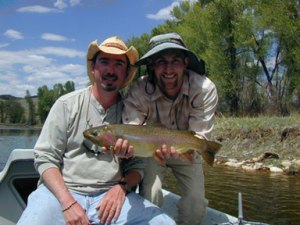Winters in the Rockies can often be long. My
favorite streams and rivers are under a blanket of ice and being
hypnotized by a bobber at the local tailwaters is not the relief I’m
looking for. It is that time of year when more hours are spent
thinking about and preparing for fishing than actually getting out and
wetting a line. Time is spent sorting through flies, fixing leaky
waders, browsing catalogs for the latest gadgets, and reorganizing the
gear I have amassed over the years - how did I manage to acquire six
nets anyway? Much of my time is also spent at the tying desk -
cranking out the flies I know are going to catch fish next season and
tweaking a few for fun of it.
As I go through my
list and inventory my bugs, there is one fly I can never have enough
of - the pheasant tail nymph. The pheasant tail was developed in
England by Avon River Keeper Frank Sawyer. Sawyer’s Pheasant Tail (P.T.)
used only natural cock pheasant tail fibers and copper wire. Today, on
this side of the big pond, various materials as well as thread is used
to enhance what many would consider the greatest nymph imitation ever
created.
There are many
variations of this popular pattern - beadheads, softhackles,
flashbacks, glass beads, rubber legs, crystal flash ribbing, etc…etc…
Tied in variety of styles, colors, and sizes, the P.T. could very well
be the only fly you would need to catch trout feeding on mayflies;
nymphs, emergers, duns, or spinners. As a guide, this is often my “go
to” fly when things get tough and produces everywhere from ponds to
tailwaters. It is also a great searching nymph when fishing new
waters. A couple years ago on a steelhead trip in Southeast Alaska the
fishing got tough and guess which fly produced - a size 14 bead
head, softhackle P.T. swung down and across.
Today, bleached or
dyed pheasant tail is available in every color imaginable and is
inexpensive. My basic arsenal includes natural, bleached, olive, red,
orange, black, and dark brown. With these colors, tied in sizes from
22-10, I can imitate any mayfly nymph. Of course I add beads and
flashy accessories on some patterns and others are tied pretty sparse.
I give them names such as Strawberry Zinger, Chocolate Sprinkle,
etc.., etc… - they’re just that yummy and fish love them. Tied
with softhackle, crystal flash, and a loose dubbed thorax, this
pattern will out-fish most caddis patterns during a caddis hatch -
it just looks buggy!
 |
Pheasant tails can bring out some
nice trout |
One of my favorite
variations, the Bead Head Soft Hackle P.T. works well in all types of
water and lends itself to a variety of fishing techniques. In rivers,
this particular pattern is one of my favorites and works well dead
drifted with a slight rod lift and swing at the end of each drift.
Many fish take the fly on the swing as it looks like an escaping
insect. Another effective method is to fish this fly down and across
much like the classic wet fly technique (make sure you throw a big
upstream mend as this slows the fly down during the swing). When I'm
guiding I'll often fish this fly as a dropper off of any dry fly
pattern - this is especially effective during the beginning stages of
a hatch. On lakes and ponds, this is a very effective fly (sizes
12-14) in the middle of the day during Callibaetis season. Use a
floating line and retrieve the fly very slowly near the surface. Pay
particular attention to shallow areas near weed beds. The B.H
Softhackle Pheasant Tail is especially useful before, during, and
immediately after a Callibaetis hatch.
Below is the fly
recipe and tying instructions for the softhackle variation. Remember;
tie many sizes, colors, and variations. Have fun and fill your nymph
boxes - you can never have too many and you will be pleasantly
surprised when those selective trout see something just a little
different and take a bite. Yum, Yum.
MATERIALS
HOOK: Tiemco 200R -
3X long, semi-dropped point. Sizes 10-22 (any 3X nymph hook)
HEAD: Copper bead
THREAD: Brown, or
color to match dyed pheasant tail
TAIL: 3-8 fibers from
the tail of a cock ring-neck pheasant (Sawyer recommends 4)
RIB: Copper wire
BODY: Fibers from
center tail of cock ring-necked pheasant ribbed with copper wire
THORAX: Syntilla
Peacockle dubbing (#46)
HACKLE: Natural or
Olive Partridge
TYING INSTRUCTIONS
1. Slide a small
brass bead onto the hook.
2. Wrap tying thread
just above the bend of the hook and tie in tips of tail feather fibers
to form the tail of the fly. Fiber tips should extend one hook gap
width past the bend. Do not trim butt ends of tail feather fibers,
these will be used to form the body.
3. Tie in a length
of fine copper wire at the hook bend.
4. Wrap pheasant tail
fibers toward the eye of the hook, stop approx. 2/3 up the shank.
5. Wrap the fine wire
forward through body, tie off.
6. Apply dubbing
loosely to form thorax.
7. Tie in soft hackle
(butt end) and make and wrap one and a half turns, tie off hackle.
8. Finish the fly by
adding a slight amount of dubbing in front of the hackle and tying
off. Note: You do not need to add dubbing for the smaller sizes, just
tie off with thread.